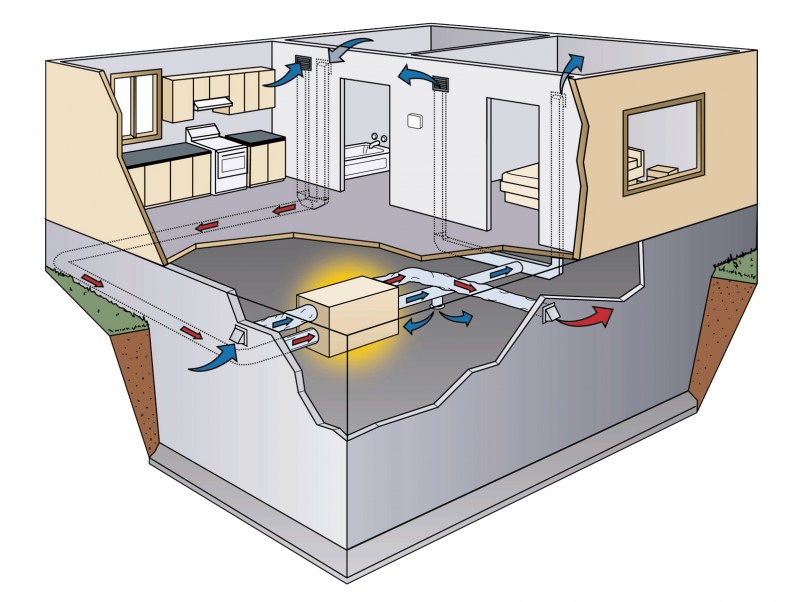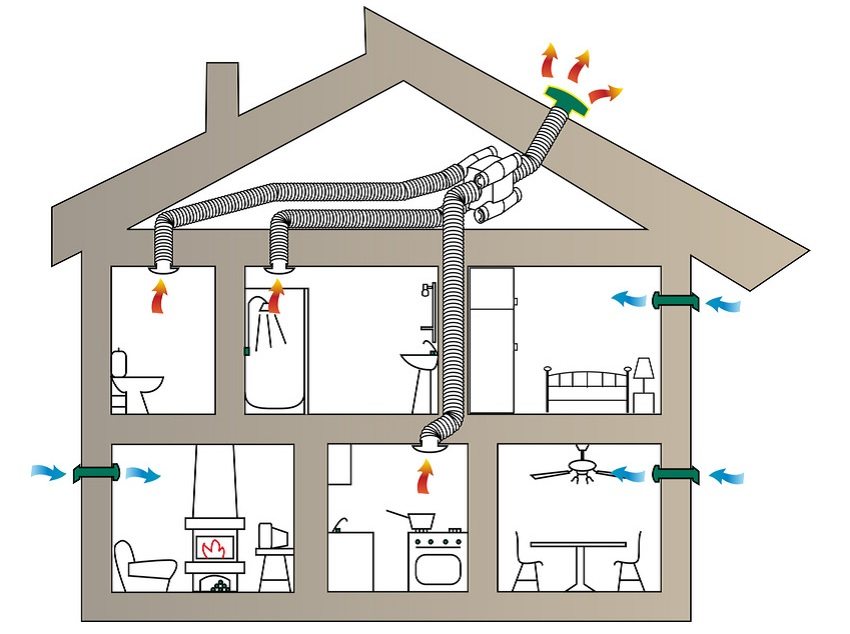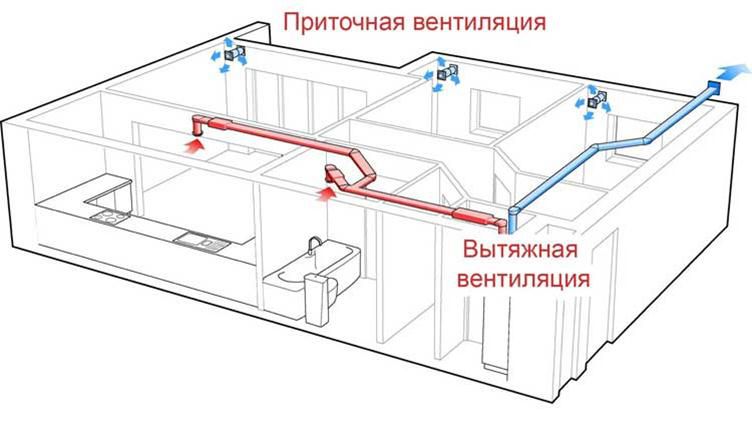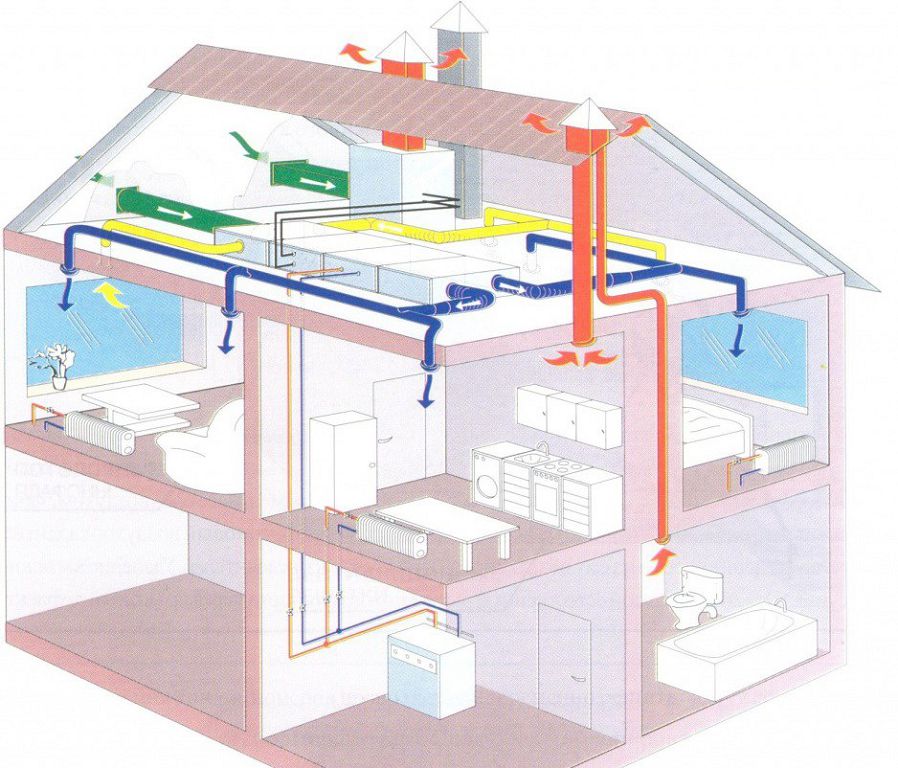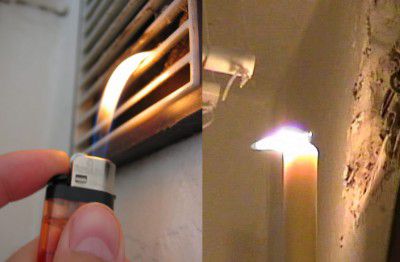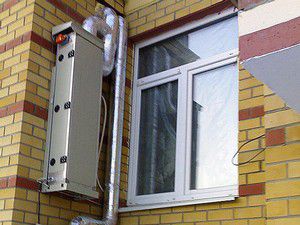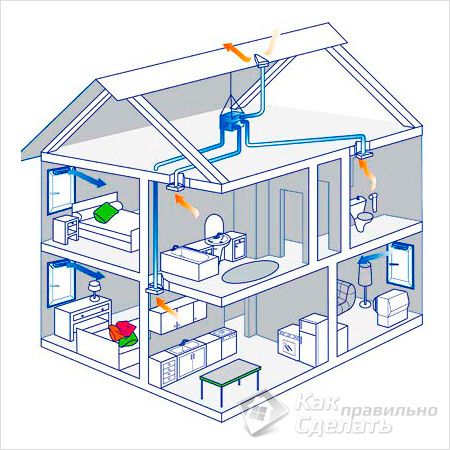The task of any ventilation scheme in an apartment or cottage is in the supply and removal of air. Moreover, it is necessary to supply a sufficient volume of air without creating a draft or cooling the rooms. According to the rules, a ventilation project is created together with a house project. But often the owners of apartments have to independently deal with the establishment of the microclimate in the dwelling. So that investments are not in vain, it is important to know the rules for creating circuits and the device for supply and exhaust ventilation. Read about this, as well as about the symbols used in ventilation schemes.
Ventilation of apartment buildings
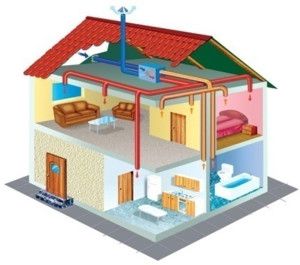
Most apartment buildings built more than 10 years ago use a natural ventilation scheme for apartments. Its principle is based on the fact that the temperature and humidity in apartments are always higher than outside. Therefore, according to the laws of physics, warm air tends upward. For its removal, vertical ventilation shafts have been created, to which ventilation grilles are adjacent from the apartments. Taking into account the schemes of the ventilation device in panel houses, air removal is organized from places with maximum heat and moisture inflows. These are bathrooms, toilets and kitchens.
A vacuum is created in the apartment, which is replenished by the method of infiltration of street air through the window slots or during ventilation.
Old wooden windows have an average air permeability of 6 - 10 kg / (* h), which is quite enough to provide an apartment or a small cottage with fresh air.
For adequate operation of the above ventilation device diagram in a panel house, the following conditions are necessary:
- The cleanliness and working condition of the exhaust shafts.
- The presence of cracks in the windows or constantly open vents.
- Free air movement in the apartment: from living rooms to auxiliary rooms.
Also, the effectiveness of the natural ventilation scheme of an apartment building is highly dependent on the weather. In summer, in hot weather, when it is cooler in apartments than outside, reverse draft can be observed. The same phenomenon is possible with strong winds. Inhabitants of the upper floors practically do not notice the operation of ventilation in any weather.
Therefore, they have to modify the existing exhaust ventilation schemes. Fortunately, for this there are a lot of convenient and simple mechanisms, which will be discussed below.
Ventilation schemes for houses and apartments
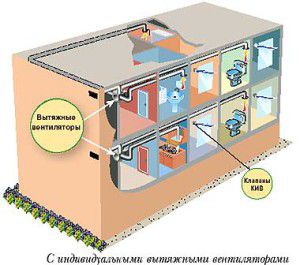
There are three ways to normalize ventilation in a residential area:
- mechanical extraction with natural inflow;
- scheme of supply and exhaust ventilation on a mechanical traction;
- mechanical inflow with natural draft.
Any of the schemes is suitable for ventilation of an apartment or private house.
Now we will tell you in detail about each of them and how to independently implement the apartment ventilation scheme using available means.
Supply ventilation systems
The supply ventilation scheme can be based on natural or mechanical draft.
In the first case, the air processing before being supplied to the room is limited to filtration. Forced ventilation can also heat or cool the air.The key device in the natural draft ventilation system is the valve.
Supply ventilation valves
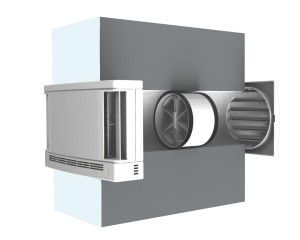
At the place of installation, supply valves are:
- wall;
- window.
The window valves are specially designed for installation on PVC windows. They are compact, discreet and very comfortable. In many modern buildings, plastic windows are installed immediately with air inlets. You can mount them on existing windows, even without the help of a wizard. To do this, you do not need to know the symbols in the ventilation circuits at all.
Without an organized air flow, the general exhaust system will not work!
Wall valves are built into the wall, for which it is necessary to cut a hole with a diameter of about 5 cm. Most often, they choose a place above the heating radiator so that the cold air first descends and warms up, and then dissipates around the room.
Both window and wall valves are equipped with a simple mechanical filter. Some models contain more complex and subtle filters. There are dampers with a humidity sensor, adjustable air flow and automatic damper closing.
Supply mechanisms for ventilation
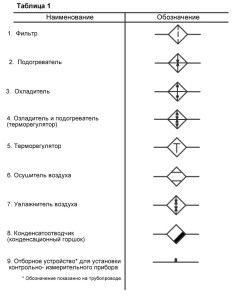
The supply ventilation scheme can include mechanical air movement devices of the most varied configurations and prices. Most air handling units are equipped with air heaters, usually electric ones. All inlets have built-in filters. Additional comfort is achieved with a silencer that suppresses the sound of the rotating blades.
The basic design of any inflow consists of:
- Supply chamber. The air comes here from the street, here it is filtered and brought to the required temperature;
- Air ducts. Through them, air is supplied to the required point;
- Fittings. Ventilation grilles, brackets and other accessories.
One of the main requirements for the supply ventilation scheme: supply air temperature from +18 degrees.
There are small monoblock air inlets that are mounted on a balcony door or wall. They do not need air ducts, but the power of such devices is also low.
Type-setting supply systems are advisable to use in ventilation systems of private houses. Air ducts run between floors or inside walls, and the unit is placed in a special room or in the attic. The supply circuit of the ventilation structure of a private house provides sufficient power, if necessary, supplies air of a certain temperature to each room. In cottages, automatic and remote ventilation control schemes are often used, for example, via wi-fi.
This constructive ventilation scheme for a private house is rather complicated, therefore it requires professional calculations and installation.
Exhaust ventilation fan
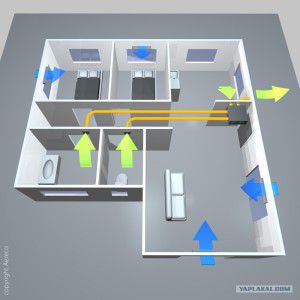
Household exhaust fans are most often installed instead of a ventilation grill in the kitchen or bathroom. These are axial fans of various capacities and functions.
Exhaust fans can be:
- wall;
- windowed.
Many models are equipped with a manually-closed lid, automatic shutters or a non-return valve. These additions prevent cold air from entering the room in winter and prevent back draft from the general ventilation of the house.
There are fans with humidity sensors that start automatically and turn off when the microclimate normalizes.
Fans with timers turn on and off according to the mode set by the owner, and models with motion sensors - when there are people in the room.
The simplest devices in the exhaust ventilation scheme are quite affordable for any consumer.
When choosing an exhaust fan, pay attention to its power.
This indicator depends on the purpose of the room and its size:
N = V * 10,
Here N - fan performance,V - the volume of the room,
V = S * h,
S - the area of the room,h - ceiling height, 10 - air exchange coefficient for kitchens, 15 - 20 - air exchange coefficient for bathrooms.
Experts advise, when calculating the volume of the kitchen, to subtract the area occupied by the furniture. This advice applies only to private houses, where the exhaust ventilation scheme is compact and kept clean.
The second indicator that you should pay attention to when choosing a fan is noise. This indicator is measured in decibels and for the best models it is 26 - 33. The more powerful the device, the louder it works!
Supply and exhaust ventilation system
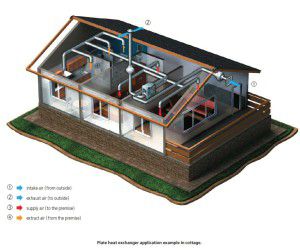
Today, in the construction of large private houses, the supply and exhaust ventilation scheme is widely used. The problem of ventilation in private houses during the cold season is the need to keep warm. Natural ventilation inevitably leads to cooling of the premises, increasing heating costs.
The supply and exhaust ventilation scheme, supplemented by a recuperator, works very efficiently and quite economically.
Principle of operation
Outside air enters the air intake, here the air is filtered and heated by a heater. The supply and exhaust ventilation circuit can be equipped with a water heater, but this greatly complicates and increases the cost of the design. Therefore, heaters are usually electric.
Waste air masses are drawn from the most humid and "dirty" rooms: kitchen, toilet, bathroom, sauna, dressing room. Through the duct system, they are pushed out onto the street above the roof level.
When calculating a similar scheme of the ventilation system of a private house, a slightly increased pressure is planned in living rooms. Due to this, the atmosphere in bedrooms and living rooms remains cleaner and the harmful radioactive gas radon does not penetrate.
So that air flows freely through the house, gaps about 2 cm wide are left under the doors or a ventilation grill is installed in the lower part.
In the cold season, the warm exhaust air passes through the recuperator, where heat is transferred to the cold supply air. By using a heat exchanger in the exhaust ventilation of a private house, you can save up to 25% of the energy used for heating.
In rooms with a gas boiler, stove or wood-burning fireplace, both forced air supply and exhaust are required.
If only the exhaust duct is brought in, the draft in the chimney will "overturn" due to the strong vacuum of air.
Ventilation equipment for apartments and houses
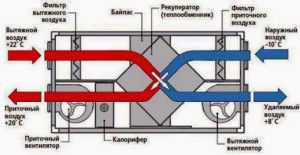
The ventilation scheme of a private house can be a type-setting system of a separate filter, heater, recuperator and air ducts, or be a monoblock. Fans, recuperator, filters and cooling system are located in a single module.
The scheme of the supply and exhaust ventilation device includes a bypass - an additional air duct that passes the supply air bypassing the heat exchanger. When it is very cold outside, the supply air goes through two channels: half through the bypass, the other to the heat exchanger. The volume of air going to the recuperator is changed so that the condensate does not freeze.
You can equip the system with a humidifier or dehumidifier, they will bring the microclimate in the house closer to the ideal for health.
The work of all parts of the ventilation system is coordinated by an automatic control circuit. The auto-adjustment module allows the owner to set the air temperature and the rate of its updating, as well as monitor the operation of individual units.
The more sophisticated the system, the more complex the ventilation control scheme.
The equipment for supply and exhaust ventilation of a private house, the schemes of which we have considered, are most conveniently installed in the attic in order to reduce the duration of the air ducts. Any room that meets the requirements is also suitable:
- the module must be accessible for maintenance and repair;
- due to the noise generated, sufficient distance from living rooms;
- convenient air duct routing.
When drawing up a diagram of supply and exhaust ventilation, it is necessary to spread the device for intake of clean air and output of exhaust air at a distance of 10 meters from each other.
Other secrets of ventilation of private houses in the video:

